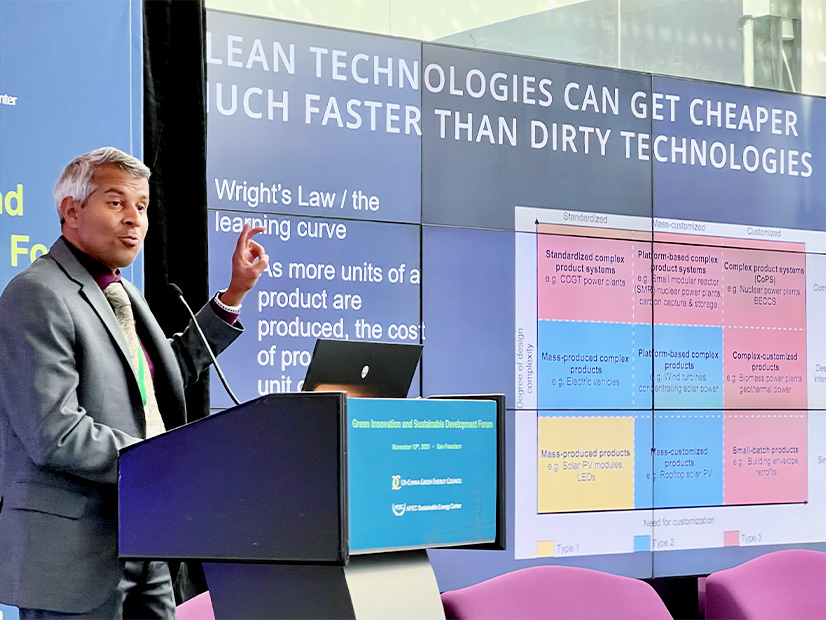SAN FRANCISCO — Policymakers must invest in scaling clean energy solutions if the Asia-Pacific region is to meet climate goals, experts said at the Green Innovation and Sustainable Development Forum held by the US-China Green Energy Council and the APEC Sustainable Energy Center in San Francisco on Nov. 13.
With increasingly expensive extreme weather events brought on by man-made climate change, the cost of rapid action is lower than the cost of inaction, said Anand Gopal, executive director of Energy Innovation.
“It will be $12 trillion cheaper to have a fast transition to net zero than it would be to have no transition,” Gopal said. However, the costs of some of climate solutions are more likely to decline rapidly as they scale, he said, citing Wright’s Law, which says the declines are most likely with products that can be mass-produced and that have lower degrees of design complexity.
Government loan guarantees have proven to be an effective way to get new technologies over early scaling issues, said Nobel Laureate and former U.S. Energy Secretary Steven Chu, who now teaches at Stanford.
“The fact that a government can come in and guarantee a loan, just in case the project defaults, will drive the cost of capital way down,” Chu said. That approach has proven its value in driving down the cost of both solar and electric vehicles, he said.
“If you want to get these rapid price drops, policymakers should trust that these will happen with clean technologies and that they will eventually save their constituents money,” Gopal said. “Leaning in early on policy, doing it in such a way that knowing that your actions will lead to a cleaner and cheaper energy future for your citizens, is very important.”
APEC’s Energy Working Group Drives Regional Action
The forum was held ahead of the Asia-Pacific Economic Cooperation (APEC) Summit, where leaders of APEC’s 21 member economies will convene to discuss a range of economic issues. APEC has an energy working group that explores regional energy issues.
“The work of APEC’s energy working group matters because APEC economies account for 56% of world energy demand, 58% of world energy supply and 68% of world electricity generation,” said Rebecca Fatima Sta Maria, executive director of the APEC Secretariat.
APEC economies account for 60% of global CO2 emissions, and 19 members have committed to achieving zero carbon emissions by 2050 or 2060, Sta Maria said.
Yongxin Zhan, co-chair of Pacific Economic Cooperation Council, said the region, which accounts for a third of the world’s population but 60% of its economic output, was dynamic in its approach to addressing sustainability goals but was still falling short of meeting the UN’s Sustainable Development Goals. Three years ago, APEC member states released the Putrajaya Vision 2040, which focuses on three economic drivers: trade and investment, innovation and digitalization, and sustainable and inclusive growth.
“We have confidence that with the common efforts of APEC member economies, the Putrajaya Vision of an open, dynamic, resilient and peaceful Asia-Pacific community and the green innovative sustainable development could be achieved,” Zhan said.
APEC’s energy working group focuses on the region’s ability to meet two goals, Sta Maria said. “The first is the collective commitment to improve energy intensity by at least 45% by 2035 compared with 2005 levels. The second goal is to double the share of modern renewables in the energy mix by 2030 relative to the numbers from 2010.”
California Plays Outsized Role in Region
While APEC member economies collectively are large, California alone carries significant weight, said David Hochschild, chair of the California Energy Commission, noting the state is home to the world’s largest geothermal plant, stationary battery project and rooftop solar PV system.
Hochschild said that, despite the media tendency to paint California’s economy as a train wreck, over the last 10 years, the state had passed Russia, Italy, France, Brazil and the United Kingdom (‘thank you to Brexit’) and this year is on track to pass Germany to become the fourth-largest economy in the world. “This has been concurrent with the largest decarbonization we’ve ever done. This has been good for our economy.”
Hochschild called California’s current era “The Great Implementation” but sees speedbumps slowing the state’s decarbonization plans.
“The speed of construction of projects is a huge problem in the state,” Hochschild said. “To construct an offshore wind project, for example, is 32 different permits. We need to have as much success on process innovation as we’ve had on technology innovation. We don’t need to do landmark policies. We just need to buckle down and focus on implementation and hire the talent for that.”
California, China Share ‘Really Robust Climate Collaboration’
Despite the Biden administration’s aim to build the U.S.’s clean energy manufacturing capacity, lessening dependence on imports from China, Hochschild sees “really robust climate collaboration” between California and China. He told NetZero Insider that the two economic powerhouses shared learnings in a recent visit to China.
Hochschild said California can learn from China’s strength in offshore wind development (“where China’s built 50% of the global capacity: we’re just getting started on that today”) and high-speed rail, an infrastructure wish list item that California has struggled to deliver.
On the other side, he said, “We can help support China with lessons learned on stationary energy storage where we’re leading the fastest-growing energy storage market in the U.S. We had an opportunity to share with the Chinese our very positive experience of bringing that onto the grid.”



